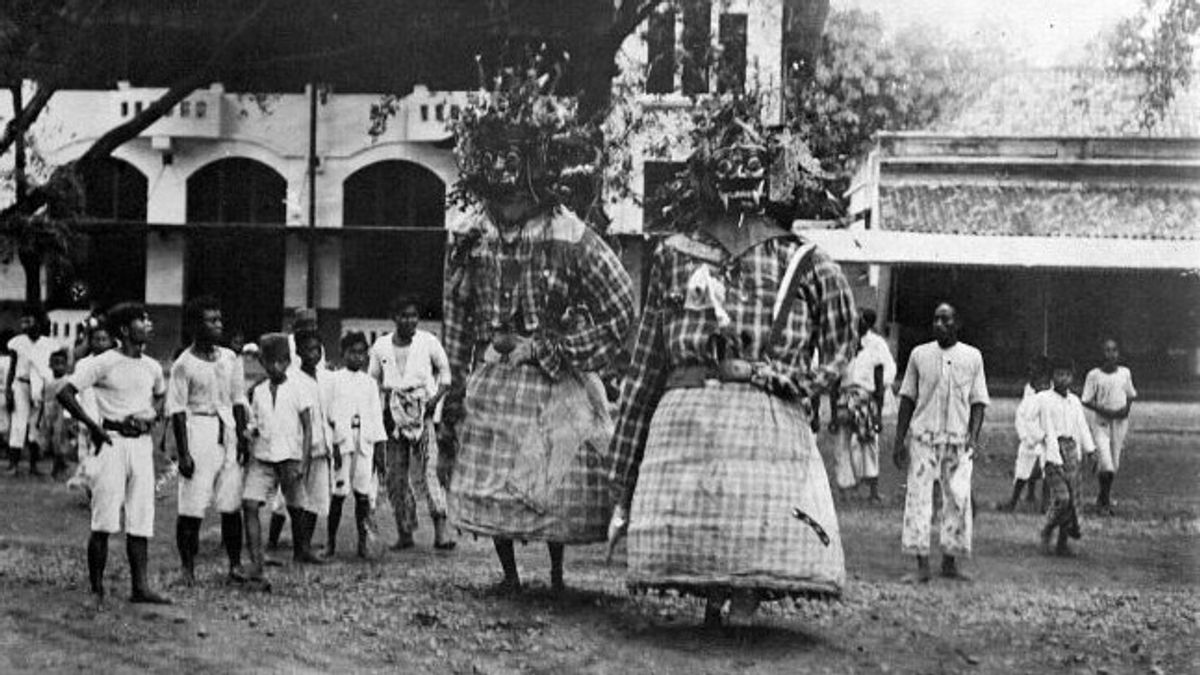JAKARTA - For Betawi people, celebrating Eid Al-Fitr in ancient times and now seems a little different. Practical lifestyle is an excuse. If now people have a focus on taking advantage of the momentum to visit each other with relatives. In fact, it used to be much more lively. The moment of Eid is like a big party where there are performances of ronggeng lenong, tanjidor, keroncong, to the most interesting thing: ondel-ondel.
As revealed by a young Betawi figure, Masykur Isnan, ondel-ondel has always been the prima donna of all the most anticipated performances when Eid arrives. This is because when the giant doll started to enter the village, people, regardless of whether they were young or old, immediately rushed out of the house to watch the waddle of ondel-ondel.
In fact, the appearance of a pair of ondel-ondel if you pay attention is a bit spooky, but it is woody. Even so, therein lies the appeal of ondel-ondel. "Even though it is scary, the reason ondel-ondel is still awaited by its arrival is none other than the variety of art fusion that has gathered together. There are music, fine arts, and dance," he said when contacted by VOI.
Betawi people are generally entertained by the presence of ondel-ondel. In fact, some of them even gave money as a token of appreciation. Not surprisingly, those who watched were absolutely sure that the presence of ondel-ondel also had an equally important value, namely as a reminder to people to always uphold kindness.
Because of this, ondel-ondel was also known to be legendary as a doll of reject bala. It is said that ondel-ondel was also used to avoid calamity by residents in the villages of Jakarta. Ondel-ondel is believed to have magical powers, such as to treat certain diseases or epidemics.
"It is said that long ago in Batavia - the name used to be Jakarta - there was an epidemic known as variola or smallpox, thanks to the procession of ondel-ondel, the plague immediately ran away from the capital. As a result, people became convinced that ondel-ondel has power, ”said Masykur Inan.
It is only natural for believers. In the past, the making of ondel-ondel was known not to be arbitrary. In the process of making ondel-ondel, a red-and-white porridge offering is usually provided as a pre-requisite. Apart from that, what is obligatory is the rujakakan seven forms, seven kinds of flowers, and the smoke of incense.
After it has been successfully made, the ondel-ondel is then given offerings and washed with the smoke of incense while chanting a spell. The same is true for the players. They also have to perform the ritual of burning incense which is usually known as "sufficiency."

The existence of ondel-ondel or what used to be called barongan has existed since Jakarta had not yet fallen into Dutch hands. Historian JJ Rizal spoke about this in his writing in Tempo Magazine entitled Ondel-Ondel dan Korupsi (2011). According to him, the existence of ondel-ondel has started to smell through the notes of an English merchant, Edmund Scott, who was in Banten during 1603-1605.
Through these notes, the existence of ondel-ondel as a symbol of repelling evil was commonly seen at that time. "However, the origins of the Jakarta ondel-ondel are hard to say as the result of an adaptation from Banten, so that the word kingdom had brought and had a lot of influence on Sunda Kelapa."
For this reason, Rizal prefers to invite the public to see the anthropological record of ondel-ondel that grew from the agrarian culture in Betawi. This is where the audience can see traces of ondel-ondel which are becoming known as part of the baritan ceremony or village clean-up in the suburbs of Jakarta, especially in Cireundeu and Ciputat.
"Anyway, Th. Piageud in Javaanse Volkvertoningen (1934) mentions a giant doll called Edmund Scott 'een reuse en een monster' that appeared at Prince Abdul Mufakhir's circumcision party that was commonly found in areas with agrarian culture as a manifestation of the village's protective power, repelling disaster. "
Furthermore, the existence of ondel-ondel as a symbol of anti-evil forces has started to become famous along with the presence of the Chinese nation which also has a tradition of parading giant dolls. Not surprisingly, the newspapers of the 1880s often reported on this tradition with the phrase "exorcising the devil, ie one very large bonnekka tjina, which Kai-losin scribbled."
Susan Blackburn, in the book Jakarta History 400 Years (2011) reveals the same thing. The popularity of the giant doll began to emerge when cholera began to spread in Batavia.
At that time, Indonesians who were individualistic made a strategy by relying on the properties of holy water that came from a sacred location and was equipped with the chants of the prayers of religious leaders. Uniquely, there are other mass rituals believed to be ondel-ondel.
"In a Malay language newspaper published in 1888, there was news about village leaders holding a parade through the area where Indonesians live while saying prayers," added Susan.
Golden ageDuring his journey, the Mayor of Sudiro was banned in Jakarta in 1954. Sudiro thought the procession of ondel-ondel was a tradition that should not be preserved because it demeaned the natives. Fortunately, after 30 years, came the savior ondel-ondel known as the governor of Jakarta, Ali Sadikin (1966-1977).
Therefore, ondel-ondel is not only presented again through a variety of events such as the Betawi life cycle ceremony (circumcision and marriage), Eid days, Jakarta birthdays, independence ceremonies, welcoming guests, and inaugurating the office. Ali also raised the degree of ondel-ondel, which was originally performed from village to village, to become one of Jakarta's icons.
As a result, during Ali Sadikin's administration, Betawi art was again raised and was not inferior to traditions from other regions. Not only Ali who cares. Betawi legendary artist, Benyamin Sueb, also popularized the reinforcements-repelling puppet by singing a song composed by Djoko Subagyo entitled Ondel-Ondel (1971).
Packed with gambang Kromong music, the song quickly became familiar to people thanks to its simple, witty lyrics. Therefore, people who hear can immediately love and catch the message conveyed by the Betawi legend through the lyrics:
Let's watch ondel-ondel, (nyok!)
Nyok kite parading ondel-ondel, (nyok!)
Ondel-ondel ade anaknye, (wow!)
anaknye nandak gel-igelan, (oi!)
The English, Chinese, Japanese, Arabic, and French versions are automatically generated by the AI. So there may still be inaccuracies in translating, please always see Indonesian as our main language. (system supported by DigitalSiber.id)









